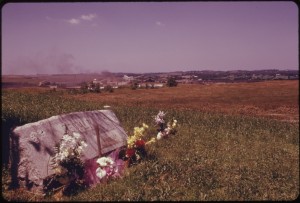By Shannon Huffman Polson
1. Drive down unmarked road in rental car to a quiet circular drive. Try to ignore the weight of undefined expectations.
2. Wish that expectations were defined. By you or someone else.
3. Push away the thought that the name on the back of the stone is the same as your name.
4. Take a deep breath. Before opening the car door, flex your stomach muscles in case memories come at you kicking.
5. Walk to the stone. Try not to remember the burial. The gaping hole. The depth of it. The cold of the day. The sound of dirt. The color of clay.
6. Kneel by side of headstone. Wonder if it is bad luck to be in front or on top of the grave. Keep to the side.
7. Stare.
8. Say the Lord’s Prayer. Say the Twenty-third Psalm. Say hello. Wonder if you are talking to your father and stepmother or to God. Wonder if wondering that is sacrilegious. Wonder why your eyes are dry.
9. Tear away the grass growing in front of the headstone. Notice the flowers you planted didn’t take (recall: trying to cut through the grass roots with the shovel, choosing flowers that could withstand extreme conditions, willing them to grow). Try to be okay with this.
10. Feel your eyes still dry. Desert dry. Aching, ancient desert dry. Work to remember the burial. The gaping hole. The color of earth. The coffins: their cold curved surfaces. The sound of a handful of dirt. The sound of a shovelful of dirt. The sound of “Amazing Grace” coming from a far away place. Taste bile.
11. Run your hand over the rough top of the headstone you chose to blend in with the landscape, the front a smooth surface to hold names.
12. Trace the names with your fingers; feel the hard edges of the letters.
13. Look at the face of the headstone. See the names. See the dates: two dates of birth, one date of death. See your own reflection.
14. Feel the stone cold against your lips. Taste soil on your tongue.
15. Say goodbye. Know you are saying this to the stone, not to your father and stepmother, and not to God, and wonder why it is still important, and why you will come back.
Shannon Huffman Polson writes about the burial of her father and stepmother in her forthcoming memoir, North of Hope: A Daughter’s Arctic Journey. She lives and writes in Seattle with her family, and holds an MFA in Creative Writing from Seattle Pacific University. Her website is: www.aborderlife.com.












